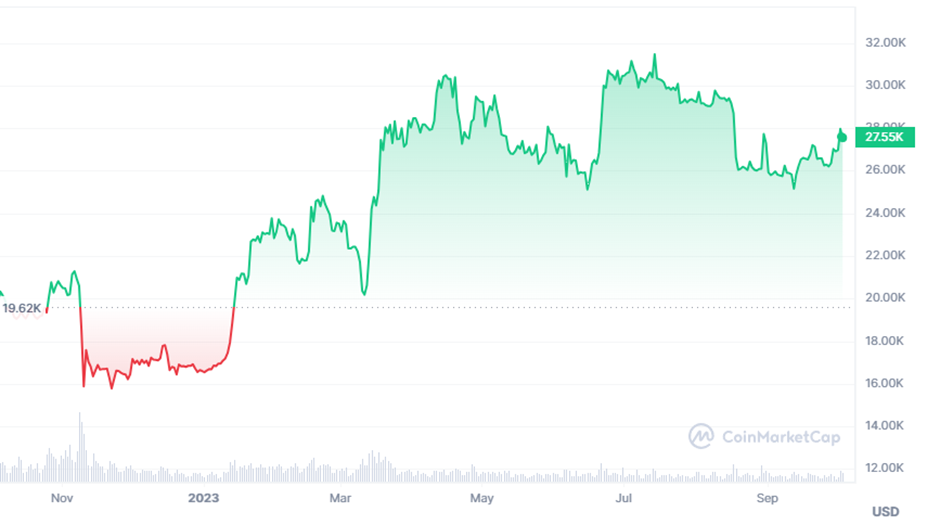From emerging controversies to regulatory shifts, the crypto market has experienced more than enough excitement in the past twelve months. But as 2024 appears on the horizon, many of us are wondering: what can we expect from crypto next year?
Join us as we explore the current state of the crypto market, addressing key factors that have contributed to current prices and investor sentiment. We’ll then summarise what the future may hold for crypto. Will this digital asset reach new heights in 2024 through a mid-year bull run? Or are there more unforeseen challenges the market is yet to face? Let’s discuss it!
The Current State of Crypto
Before exploring the future state of crypto in 2024 and beyond, we need to examine the current condition of the industry. From a current bear market to the fall of exchanges, crypto has certainly had a whirlwind year. Let’s look into the state of crypto as we come up to the end of 2023.
The Bear Market
The crypto space entered 2023 with much uncertainty and a notable lack of consumer confidence. In January, the industry’s market cap was down 65% from record highs in November 2021. It was clear that crypto faced the start of 2023 in a bear market.
In the trading world, there are both bear markets and bull markets. A bull market refers to a large upswing in the markets, often corresponding to periods of economic growth. On the other hand, a bear market refers to a major market downturn and often parallels a shrinking economy. Typically, experts do not consider it to be a true bear market unless prices have fallen over 20% from recent highs. Bear markets usually span around ten months. But, they can persist for several years.
A bear market can occur for several reasons. In the case of the 2021-2023 bear market, experts have proposed several theories to explain its causes. The most obvious answer is that rising inflation and interest rates worldwide have reduced the average investor’s cash flow. When traders need to pay higher amounts for goods and services, they’ll have less to put towards their crypto investments.
Additionally, key incidents throughout the past few years have caused uncertainty among citizens regarding the future. This directly results in them becoming more risk-averse and, therefore, putting less of their capital towards volatile assets such as crypto.
The good news is that in recent months, the crypto sector has shown clear signs of recovering from the bear market. For instance, Bitcoin (BTC) has experienced near-constant growth throughout the year. Elsewhere in the market, crypto prices appear to have stabilised, at least for now.

Source: CoinMarketCap
Crypto Regulation
Another factor that has drastically restricted the growth of crypto assets over the past few years is regulatory uncertainty within the sector. Although governments around the world are taking steps to regulate cryptocurrency, progress is slow, with new obstacles constantly popping up.
Most recently, the European Union has attempted to fight money laundering by extending the scope of the rules related to the transfer of crypto assets. This means that virtual asset service providers such as crypto exchanges must collect information about both senders and beneficiaries, regardless of the amount of assets being transacted. This aims to ensure the traceability of crypto asset transfers to identify and prevent suspicious transactions more easily.
This development occurred just a few weeks after EU policymakers finalised an agreement on the Markets in Crypto Assets (MiCA) proposal. However, regulators have faced an upward battle concerning reducing money laundering, with one of their main oppositions being privacy coins.
Privacy coins protect the privacy and anonymity of users by obfuscating transaction data. Due to their unique attributes, privacy coins are a direct threat to anti-money laundering regulations. Whilst in some jurisdictions, privacy coins are outlawed, other governments are still attempting to reach their own solutions.
There are further futile efforts to regulate crypto assets elsewhere in the industry. For investors themselves, many are hesitant to embrace changes pushed by authorities. Much of the allure of crypto assets comes from their lack of regulation and the absence of financial intermediaries. An increase in regulatory framework would appear to oppose these defining characteristics. Traders also argue that more regulation will stifle innovation and impede the growth of the crypto market.
FTX
The current state of the crypto markets has also been directly affected by the fall of FTX, one of the world’s biggest cryptocurrency exchanges. This unprecedented collapse caused a ripple effect across the crypto sector and will likely continue to have repercussions on prices for years to come.
November 22 marked the beginning of the end for FTX as fraud within the company was uncovered. A business that was once handling up to $1 billion worth of transactions every single day was under sudden scrutiny, and it all went downhill from there.
Just a few weeks after FTX’s balance sheet was leaked, showing that billions worth of customer assets were missing, the company’s CEO stepped down. Shortly after, the crypto exchange experienced a possible hack, and hundreds of millions worth of crypto tokens were stolen.
The collapse of FTX is known as “one of the biggest financial frauds in US history” and impacted countries worldwide. To this day, crypto trading platforms are continuing to experience the fallout. This is because FTX investors suffered massive losses, resulting in many of them leaving the crypto market altogether. Traders of other cryptocurrency exchanges also followed suit, worried that if they stayed, they would meet the same fate as FTX users.
The Crypto Snowball
Unfortunately for the crypto and financial markets, a decrease in consumer confidence can create a snowball effect. Decreasing prices that are a direct result of the above factors can lead to panic selling as traders scramble to minimise losses. This leads to a further fall in prices and subsequently reduced liquidity in the market.
As prices begin to experience an even sharper decline, uncertainty floods the sector, and the snowball continues to increase in both size and speed. Similar to a real-life snowball, once this negativity gains momentum, it becomes increasingly harder to stop. Investors are continuing to exit their positions, whilst newcomers are deterred from making trades, thus continuing the negative cycle.
The Future of Crypto
With the crypto snowball in full effect, how likely will the crypto industry recover and even flourish next year?
If the crypto sector does indeed enter a bull market, as experts predict, it could reverse the snowball effect. The combination of more traders, higher prices, and positive media coverage may flip the market in a completely different direction. However, even if the market does face a revival, crypto still has other obstacles.

Source: Unsplash
Crypto’s Challenges
One of crypto’s main challenges next year will likely be an increase in regulation. As we’ve said, many traders are resistant to change within the industry and do not accept increased regulatory measures with open arms. Some fear losing control over their assets and worry that new restrictions would compromise their privacy.
Unfortunately, despite this resistance, many new acts will come into action by the end of next year. The most notable of which is MiCA. Policymakers are already putting in the groundwork for this act and are aiming for all rules to be in full effect before the beginning of 2025. This will likely impact hundreds of different assets, ranging from privacy coins to stablecoins. Other governments are also establishing their own regulations for crypto assets elsewhere in the world.
However, there is still a positive side to cryptocurrency regulations. New rules can provide consumer protection and enhance market integrity by preventing illegal activities from taking place within the sector. Although many believe that regulation can stifle innovation, it may do the opposite. By establishing clear guidelines, regulation can help businesses navigate the crypto landscape and enable the fostering of industry developments.
Additionally, the rise in regulation has led to the emergence of user-oriented crypto service providers. User-friendly crypto exchanges such as Kraken have significantly increased their user base, whilst broker-matching platforms like Bitcoin Up have paved new ways for beginners to enter the market.
Hopefully, as the crypto market grows, regulatory bodies and crypto traders will happily co-exist in the following years.
Bitcoin’s Halving Event
One key event that is occurring in 2024 and will have a dramatic impact on the market is the Bitcoin halving event. Approximately every four years, after 210,000 blocks in the Bitcoin network are mined, the block reward given to miners is cut in half. This results in the rate at which new Bitcoins are entering circulation reducing by around 50%. As this happens, the supply of this currency decreases, resulting in its demand increasing.
Many investors are eagerly anticipating the next halving event, which is due to happen around April next year. Some enthusiasts believe Bitcoin could reach $46,000 by Q1, whilst more optimistic traders think the coin will soar up to $100k. However, only time will tell the true impact that this event has on the cryptocurrency market.
Conclusion
Overall, in the transformative world of cryptocurrency, we can only be sure of one thing: the future of crypto is uncertain, and all we can do as traders is hope for the best. We all have differing opinions regarding the state of crypto in 2024, with some of us being more optimistic than others. So, considering the information we’ve discussed in this article, what do you believe the future holds for cryptocurrency?
Risk Disclosure: Trading in cryptocurrencies involves high risks including the risk of losing some, or all, of your investment amount, and may not be suitable for all investors. Prices of cryptocurrencies are extremely volatile and may be affected by external factors such as financial, regulatory, or political events. The laws that apply to crypto products (and how a particular crypto product is regulated) may change. Before deciding to trade in financial instrument or cryptocurrencies you should be fully informed of the risks and costs associated with trading in the financial markets, carefully consider your investment objectives, level of experience, and risk appetite, and seek professional advice where needed. Kalkine Media cannot and does not represent or guarantee that any of the information/data available here is accurate, reliable, current, complete, or appropriate for your needs. Kalkine Media will not accept liability for any loss or damage as a result of your trading or your reliance on the information shared on this website.





